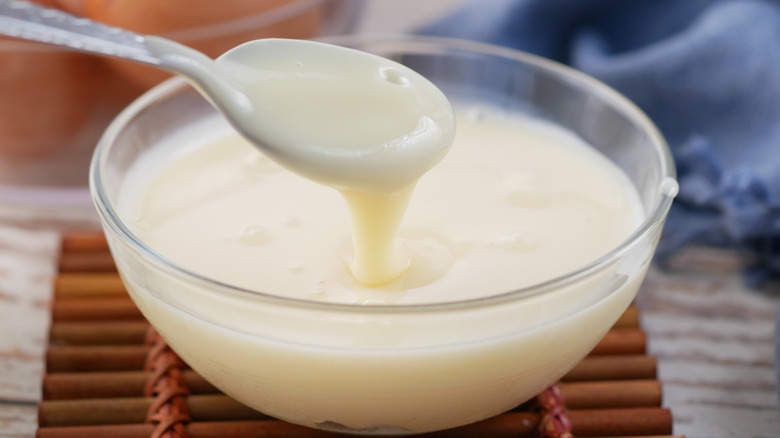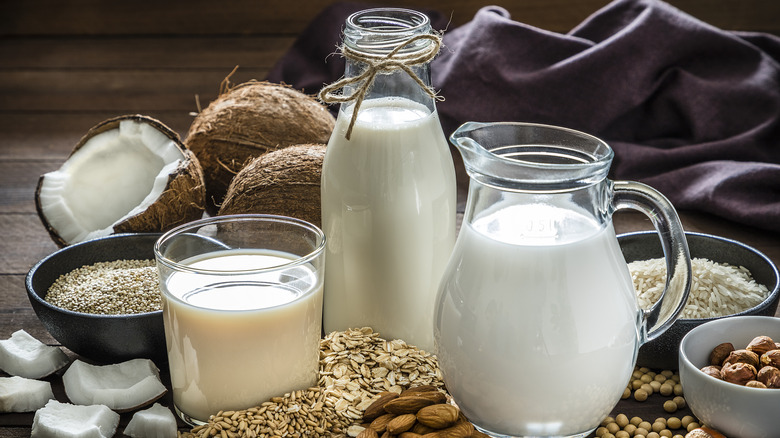What Kind Of Milk Goes Into Tres Leches Cake?
It's called tres leches cake because, well, it contains three (tres) different kinds of milk (leche). Though there have been debates over its exact origins, this staple of Latin American desserts is beloved by foodies around the world and is distinct for its intense, sweet flavor and its luxuriously moist texture. That texture comes from the fact that the three different types of milk aren't just part of the recipe; they are soaked into the sponge cake itself.
The three kinds of milk used in most recipes are: whole milk, condensed milk, and evaporated milk. And yes, they are used in the recipe not by mixing them into the cake during the initial preparation but by simply pouring them on the finished product. The whole point of tres leches is that the milks soak into the finished yellow sponge cake. You would be forgiven for thinking this creates a soggy texture. But instead, it produces a specific texture that is at once dense and creamy, almost like a pudding, but with more structure.
From there, it's topped with yet another dairy product: whipped cream. Some recipes call for strawberries or other kinds of fruit, still others for a bit of cinnamon sprinkled on the top.
What are the differences between milks?
The first milk — whole milk — is simple enough to distinguish. That's the regular, everyday milk you buy in the gallon or half-gallon jugs. But what exactly is the difference between evaporated milk and condensed milk? Both are the kind of thing you're likely to find coming in those smallish, shelf-stable cans, not in the refrigerated dairy aisle, but in the baking aisle, not far from the flour and confectioners' sugar. Both are forms of concentrated milk in which most of the water content has been removed.
Evaporated milk is used as a milk substitute when the fresh stuff is unavailable; while it's easily poured from its can and tends to retain much of the consistency of regular milk, condensed milk is notably thicker, with an almost syrupy consistency. This is due to the added sugar, which naturally makes condensed milk sweet. Some cans of condensed milk will be labeled "sweetened condensed," but they are the same thing.
Though there are recipes out there for sugar-free versions, those tend to just use sugar-free sweeteners. Bakers looking for a non-sweet version of condensed milk will typically just use evaporated milk to get the same richness.
Can you use milk substitutes in tres leches?
Difficult as it might be to accomplish, there are, of course, those who will be wondering if you can pull off a tres leches without, well, the leche. Nowadays, all sorts of health concerns come up in relation to dairy, not the least of which is lactose intolerance. And, of course, vegans love dessert, too.
At the same time, the number of lactose-free or plant-based milk substitutes seems to be ever-expanding, from soy milk to almond milk to oat milk. As far as substitutes for regular whole milk will go, most of those will do the trick. Finding worthy subs for condensed or evaporated may prove to be a bit more of a challenge.
As it turns out, there are plenty of vegan and dairy-free recipes for tres leches out there. Some call for using coconut milk, and indeed there are sweetened condensed versions of coconut milk out there. Regular coconut milk subs in for both whole milk and evaporated milk, though this technically makes it a dos leches. There are also, it should be pointed out, dairy-free versions of both evaporated and condensed milks to be found out there, typically made from almond, oat, or coconut.


